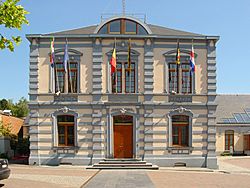Huldenberg facts for kids
Quick facts for kids
Huldenberg
|
|||
|---|---|---|---|

Municipal hall
|
|||
|
|||
| Country | Belgium | ||
| Community | Flemish Community | ||
| Region | Flemish Region | ||
| Province | Flemish Brabant | ||
| Arrondissement | Leuven | ||
| Area | |||
| • Total | 39.64 km2 (15.31 sq mi) | ||
| Population
(2018-01-01)Lua error in Module:Wd at line 1575: attempt to index field 'wikibase' (a nil value).
|
|||
| • Total | Lua error in Module:Wd at line 1,575: attempt to index field 'wikibase' (a nil value). | ||
| Postal codes |
3040
|
||
| Area codes | 016, 02 | ||
| Website | www.huldenberg.be | ||
Huldenberg is a town, also called a municipality, located in the Belgian province of Flemish Brabant. It's a place where many smaller towns and villages come together. These include Huldenberg itself, Loonbeek, Neerijse, Ottenburg, and Sint-Agatha-Rode.
As of January 1, 2011, about 9,464 people lived in Huldenberg. The total area of the municipality is about 39.64 square kilometers. This means there are about 230 people living in each square kilometer.
Huldenberg is also home to the Belgian part of the House of Limburg-Stirum, which is a very old and important family.
Sports in Huldenberg
Huldenberg has its own football club called VK Huldenberg. This club was formed when two other local teams, FC Huldenberg and VK Rode, joined together.
Local Market Day
Every Tuesday, you can visit a lively market in Huldenberg. It runs from 8 AM to 1 PM. The market is held at the Gemeenteplein, which is a square near the town hall.
A Visit During World War II
Towards the end of World War II, a special visitor came to Huldenberg. Her name was Mary Churchill. She was the daughter of the British Prime Minister at the time. Mary was part of a British all-women anti-aircraft group. This group was stationed in Huldenberg for three months.
During her stay, Mary was welcomed by the mayor of Huldenberg, Count Thierry de Limburg Stirum, and his wife, Princess Marie of Croÿ. Mary Churchill wrote that she found the local people very friendly and helpful.
Gallery
-
Freedomtree (Vrijheidsboom) (platanus) and a monument from 1906
See also
 In Spanish: Huldenberg para niños
In Spanish: Huldenberg para niños











